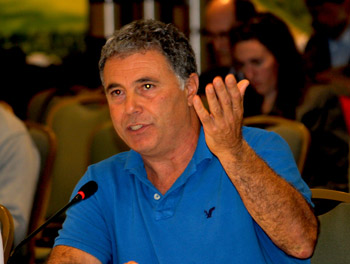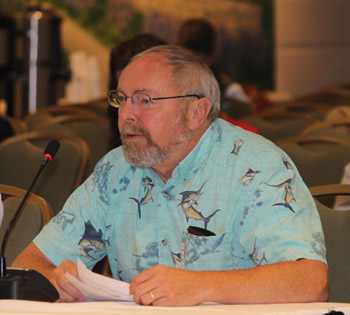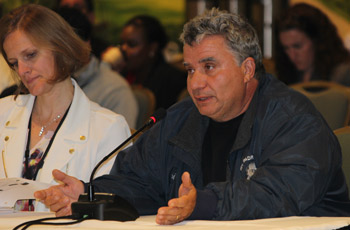Cod: End of the Small-Boat Fleet?
by Laurie Schreiber

“The only data behind the assessment comes from trawl surveys. It needs to be supplemented, or we’re going to always be taken for a ride,” We should be seeing bad signs in the fishery, and we’re not. The catch rates have been amazing, and the data show it’s throughout the Gulf of Maine. Vito Giacolone, Director, Northeast Seafood Coalition, Gloucester. Fishermen’s Voice photo
NEWPORT, R.I. – Smaller inshore groundfishing vessels in the Gulf of Maine are expected to be devastated by new measures to protect Gulf of Maine cod.
The inshore groundfishing fleet could disappear all together, along with associated shoreside support businesses.
The new measures close vast swaths of fishing grounds to groundfish vessels, in order to protect remaining codfish spawning stocks. The measures also ban fishermen, who steam outside the closed areas, from retaining any cod.
“Just cut to the chase and say, ‘We don’t want you small guys around anymore,’” Gloucester fisherman Russell Sherman told the New England Fishery Management Council (NEFMC) at its November meeting. “Because we’re not going to be around. Where’s the character and flavor of the industry going to be, after 400 years?”
At that meeting, NEFMC voted on new fishing rules designed to protect remaining Gulf of Maine cod, an inshore stock of fish that, according to a recent assessment, has declined to historic low levels of only 3-4 percent of levels considered sustainable. The goal is to rebuild the stock within 10 years.
The decision follows emergency measures—broad-scale rolling closures and a 200-pound GOM cod trip limit—imposed earlier in November by the National Marine Fisheries Service (NMFS), to remain in effect at least until April 30, 2015. NEFMC measures will replace NMFS’ restrictions beginning on May 1, 2015, the start of the next fishing year.
NEFMC measures, pending NMFS approval, are expected to have dire economic impacts on fishermen, particularly the small, inshore day-boat fleet fishing off southern Maine, New Hampshire and Massachusetts.
NEFMC imposed an annual catch limit on Gulf of Maine (GOM) cod of just over 386 metric tons (850,000 pounds) for the 2015 fishing year—a 75 percent drop from the past year’s limit of about 3.5 million pounds, which was already considered low.
Broad areas will be closed to all commercial groundfish boats, during particular times of the year, to protect GOM cod spawning areas. The recreational fishery, including party and charter boats, will not be subject to the new closed areas, but also will not be able to catch any Gulf of Maine cod when fishing there.
NEFMC rejected a proposal to ban lobster traps from the closed areas.
Inshore Gulf of Maine ports and small vessels under 50 feet are expected to experience 30-70 percent revenue losses in 2015, compared with 2014, as a result of the new measures, which come in the form of Framework 53 to the region’s groundfish management plan.
“I suspect operators and even entire ports won’t see groundfish activity under any of these options,” Northeast Fisheries Science Center (NEFSC) economist Chad Demarest told NEFMC during a presentation on economic impacts of the measures. “Under the closure scenarios, those vessels don’t have the option to continue fishing.” Small vessels don’t have the range to steam beyond the closures.

David Goethel Portsmouth, NH. Goethel said the last two cod assessments drastically underestimated GOM cod’s spawning stock biomass. “At least you should approve status quo for 2015—and let’s fix the stock assessment that’s performing abysmally.” Fishermen’s Voice photo
Demerest said impact models predict that GOM cod quota will flow to larger vessels capable of steaming beyond the closed areas to open areas. They will leverage the available cod quota to fish on healthy stocks. Thus, he said, larger vessels could see a slight increase in revenue.
“When you’ve got a case where Gulf of Maine cod is highly restrictive and you can make more money fishing offshore catching other things, that’s where the model is saying the quota should flow,” Demerest said. “But a lot of people inshore don’t have access to those stocks.”
Demerest said fishery scientists are concerned that zero retention of cod will make it impossible to know exactly how much cod is thrown overboard as bycatch, unless observers are onboard each trip.
The 386-metric-ton allocation must be divided between the industry’s 19 fishing sectors. There’s a risk that one person could catch his sector’s entire allocation in one fishing trip, Demerest said.
Demerest said small groundfish vessels will have to relocate to southern New England or stop fishing all together: “Some ports from Cape Cod to southern Maine that have been active in the groundfish fishery may not have groundfish landings at all in 2015.” Shoreside businesses and ports may be forced to consolidate or may disappear all together, Demerest said.
Over the past couple of years, as the quantity of fish landed has decreased, the price has stayed constant or decreased, Demerest said. “That’s also scary.” Previously, drops in quantity meant prices went up, helping fishermen to break even. Now, declining quantity and declining prices will mean losses for fishermen and could spiral into loss of market and infrastructure.
In addition, he said, profit margins will decrease due to additional operational costs, such as fuel, ice and food, to steam past the closed areas.
“When the infrastructure goes away, it doesn’t ramp back up immediately. It takes years,” said Demerest. “It’s difficult to predict what 10 years out will look like after this.”Then again, Demerest said, the long-term picture doesn’t look good if there are no fish to catch either.
Greater Atlantic Regional Fisheries Office chief John Bullard said 386 mt is too high, given the mandate to rebuild the stock within 10 years. By federal law, fishery regulators are required to end overfishing.
“I think that’s a goal we need to fight for,” Bullard said. “I don’t want to manage cod under the Endangered Species Act. I think that’s the worst way in the world to manage fish. But we’re getting to that status with the condition this is in.”
Hampton, N.H., fisherman David Goethel, who runs the 44-foot fishing trawler Ellen Diane, said GOM vessels have no place to relocate to.
“They don’t have southern New England fishing permits. So they can’t relocate,” Goethel said. “This is a shutdown of the small boats and business as normal for larger boats that already fish around closures….When these closures occur, a lot of these places will never open up to mobile gear again. You turned my fishery over to the lobster fishery, and I’m not getting it back unless you say, ‘Get your traps out of there.’ Thousands of traps are set up on that bottom, and the chances of you getting those people out of there is infinitesimal. So these are de facto permanent closures as you’ve constructed them.”
Some fishermen disagreed with assessment results that said the GOM cod stock is at a disastrous level.
Goethel said the last two cod assessments drastically underestimated GOM cod’s spawning stock biomass. “I think its closer to 10,000 tons, and the quota should be raised, not lowered,” Goethel said. “At least you should approve status quo for 2015—and let’s fix the stock assessment that’s performing abysmally.” Goethel said, in the early 1990s, there was clear evidence of poor haddock spawning stocks. “I caught one haddock for the year,” he said. But fishermen are still catching thousands of pounds of cod—an indication that they’re present and spawning. The problem is with the assessment, he said.
Others agreed.
“Something’s wrong somewhere,” said Gloucester fisherman Paul Vitale. “So let’s figure out what it is, instead of destroying all of us. I started fishing inshore 1997. Every year, every species, there’s more and more. You keep saying it’s less and less. We keep proving you wrong.”
Gloucester, Mass., fisherman Joe Orlando, president of North East Fishery Sector II, said vessel trip reports show codfish are everywhere. Boats in his sector, he said, are taking thousands of pounds of cod. “We’re not lying. We’ve got observers aboard our boats,” Orlando said. “And there’s fish coming in all sizes, from baby codfish to large codfish.” Orlando said that, with hundreds of thousands of pounds of flatfish at stake, “We’re not going to lose our business because of codfish. We’re going to lose our business because we can’t catch everything else.”
Orlando added that 90 percent of Sector II is small boats, and most are one-person operations. He said small boats will be forced to steam beyond their range, representing a safety hazard. “You’re going to have blood on your hands,” he said.
Another Sector II fisherman said the first six months of this fishing year, Sector II landed 80,000 pounds of cod, mixed with other species. In the first two weeks of November, as fishermen made a push to use their cod quota before the emergency action took effect, they landed 40,000 pounds of cod in two weeks—plenty of proof that cod are out there, he said.
Vito Giacalone, a Gloucester fisherman and policy director of the Northeast Seafood Coalition, said data coming from the industry itself show that cod is in better shape than indicated by the recent assessment. The only data behind the assessment comes from trawl surveys. “It needs to be supplemented, or we’re going to always be taken for a ride,” Giacalone said. “It’s too sparse a sampling. You’re not looking at fishery-dependent data.….We should be seeing bad signs in the fishery, and we’re not….The catch rates have been amazing, and the data show it’s throughout the Gulf of Maine. So you’ve got to work with the industry.”

Gloucester, Mass., fisherman Joe Orlando, president of North East Fishery Sector II. Vessel trip reports show codfish are everywhere. Boats in our sector are taking thousands of pounds of cod. We’re not lying. We’ve got observers aboard our boats.” Fishermen’s Voice photo
But William Chaprales, a commercial fisherman out of Sandwich, Mass., said GOM cod has disappeared in his area. He said he’s fished for cod off Cape Cod most of his life, and today there’s no more cod to catch in that area. A decade ago, Chaprales said, “We had a fishery down there. We were bringing in 2,000 pounds of cods with hooks per trip. Every time we went out, we’d come back with a boatload. Now, you can put 10,000 hooks in the water and you’re lucky if you catch one. So there’s definitely a problem.”
A Hyannis, Mass., charter boat captain said the recreational fleet in that area agrees with the assessment. “It’s gotten worse and worse,” he said. “And the for-hire fleet is real good at finding them. These fish are in trouble. It’s bad. Georges Bank is worse.”
According to NEFMC, the GOM cod stock is comprised of two genetically distinct groups with small aggregations whose spawning activity occur at predictable times and locations. At one time, numerous aggregations of spawning cod could be found along the GOM coast. “Unfortunately, most of these spawning grounds are now vacant, and current cod spawning activity appears restricted to a narrow range of coastline from New Hampshire to Massachusetts,” NEFMC said. Some of the remaining GOM cod spawning aggregations are well-documented and small seasonal fishery closures have already been implemented in an attempt to protect them from disruption and depletion. “However, these examples, as well as similar experiences in other cod stocks, have pointed to a need for broader-scale measures…to prevent further loss of population structure and enhance the potential for recruitment success in the future,” NEFMC said.
According to the economic impact report, vessels in the 30-foot to 50-foot size class are predicted to see 30-60 percent declines in gross revenues fleetwide. Vessels in the 50-foot to 75-foot size class are predicted to see a 10-15 percent reduction. Vessels 75 feet and larger are predicted to see slight gains.
“This modeling points to two conclusions, one relatively obvious and the other perhaps counter-intuitive,” the report says. “The former is the relative magnitude of the predicted impacts on small inshore GOM vessels. Economic impact statements have for years been predicting significant losses for this component of the fleet, and it has surely been disproportionately affected as the groundfish fishery saw gross revenues decline from $120 million in fishing year 2011 to $79 million in fishing year 2013. But the additional declines forecasted here will present serious and perhaps unprecedented difficulties for these vessels, owners and crew.
Ports may see 50-80 percent declines in revenues from groundfish, and many vessels will either be forced to relocate or stop fishing altogether. It seems possible that some ports from Cape Cod to southern Maine that have been active in the groundfish fishery may have no groundfish landings whatsoever in fishing year 2015, regardless of the measures ultimately selected. The impacts on shoreside businesses in ports throughout the inshore GOM are difficult to predict, but infrastructure and facilities supporting fishing operations may be forced to consolidate, and may disappear altogether. Relocation of vessels to southern New England ports is likely. The impact of relocation on fishing families is an important issue that is difficult to quantify.”
The closures will “effectively force vessels that would otherwise choose to fish, to no longer fish” the report says. “The model assumes that their quota will flow to those (larger) vessels that can use it. Whether this proves to be the case, or not, will remain to be seen.”
The proposal to ban lobster traps from the closed areas, was made due to reports that traps have high bycatch of cod and potentially disrupt spawning behavior. But NEFMC said the matter needs further study. Bill Adler, executive director of the Massachusetts Lobstermen’s Association, said that, of 3,600 trap hauls he made over the past year, he found only three cod, and they swam away in good condition when he released them. In most cases, Adler said, keeper fish are too large to get in through a trap’s ring. Banning traps from closed groundfish areas would only move the lobster fleet into open groundfish areas, resulting in gear conflict, he said. And traps do not inhibit groundfish spawning, he said. “That idea is speculative and has no basis in fact,” he said.
“It is a shame that the groundfish fleet and lobster fishermen are being turned against each other,” Adler added. “Why turn fishermen against fishermen?”
Maine Department of Marine Resources (DMR) commissioner Patrick Keliher issued a statement that said the agency understands the importance of the issue of cod bycatch, but believes the actual bycatch of cod in the Maine lobster fishery has been overestimated. A rough estimate produced by a study in 2008 did not account for significant variability of bycatch in different parts of the coast, in different depths, and in different seasons, Keliher said. Keliher said the DMR will urge NEFMC to conduct additional analysis, and will schedule conversations with both the lobster and groundfish industries as the issue moves forward.
